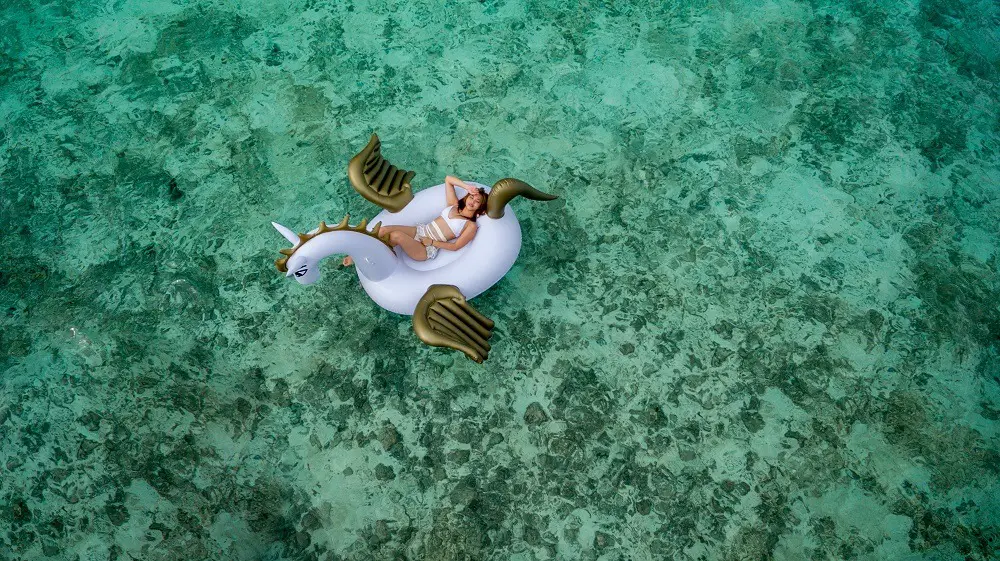
Maldives on a Budget | Budget Tips + 6 Days Itinerary
We all dream of visiting Maldives — the famous water villas, blue beaches, snorkeling and diving in the ocean to see corals and wildlife such as fishes, sea turtles, even sharks. Maldives used to cater exclusively to luxury travelers, but recently it’s now possible to go here on a budget.
In fact, this is where I spent my birthday solo back in 2018. Here’s a budget travel guide to Maldives, including budget tips and a sample 6 days itinerary.
Contents
An overview of Maldives
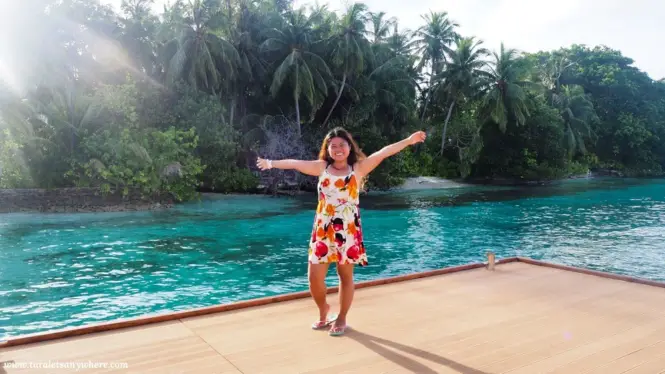
Maldives is a small island nation in South Asia. It is composed of over 1000 islands, over which over 200 are inhabited by locals or converted into private resorts. You literally have lots of options especially when it comes to private resorts you can stay at.
Here are some things you need to know before you go:
Visa requirements
No pre-visa arrival is required in Maldives. All nationalities get a 30-day free visa on arrival.
I have a Philippine passport. My experience with immigration is smooth; I was asked for passport and nothing more.
Language
The official language of Maldives is Dhivehi. English is also widely spoken so you won’t have any problems with communication.
Currency
Maldives uses Maldivian rufiyaa (MVR).
- Bring USD and then change it to MVR via Bank of Maldives in Male Airport arrival hall or via the Currency Exchange counter at Newtown Inn in Hulhumale. It’s not advisable to exchange currency in Male due to long queues.
- Establishments accept both MVR and USD, but generally if you pay in dollars you will still receive rufiyaa in change. I suggest changing a small note (such as $50) when you arrive and paying the rest of your purchases in dollars.
- Keep the receipt of the exchange because you’ll need it to convert your remaining money back to a foreign currency. You can only do this after checking in to your return flight, via currency exchange in the departure hall.
Season and best time to visit
Maldives has a tropical climate with an average temperature of 30 C, so it can be visited all-year-round.
There are 2 seasons in Maldives. Dry seasons run from January to March and wet season runs from May to October. There may be heavy rain showers any time of the year but they tend to be short, so you don’t have to worry about them.
If you want to get the best weather, visit during the dry season. Some people attest that August to September is the best time go to because it’s just starting to get into high season, so you can enjoy cheap prices and great weather. I went here in June, and days were mostly cloudy with several hours of sunshine.
Do’s and Don’ts
Maldives is a Muslim country. In fact, citizens are required to follow Islam as religion so its population is 100% Muslim. As such, it’s a pretty conservative country. There are do’s and don’ts you need to know:
- In general, wear conservative clothing in public — shirts, shorts or dresses will do. Also, it’s not allowed to wear bikinis in a public beach. However, today this isn’t really an issue since local islands have designated bikini beaches. You can also freely wear bikinis in picnic islands, sand banks, dive boats and private resorts. Accommodations may also have their own private beaches, gardens or sunbathing terraces.
- Alcohol is prohibited in inhabited local islands, including the capital Male. However, you can still consume alcohol in private resorts or safari or tour boats which may offer alcohol for tourists. Just don’t bring it back to your guesthouse.
Others
For other information for first-timers, I’ve compiled everything on 10 Things to Know Before Visiting Maldives.
How to get here
From Manila, there are 2 airlines that fly to Male International Airport (Maldives):
- Airasia – with Kuala Lumpur layover
- Scoot – with Singapore layover
You have to wait for promo or booked several months in advance to get a good price (P8000-9000 round-trip). Otherwise, you’ll have to spend some P17,000-22,000 ($300-400) round-trip.
I booked my flight tickets from Kuala Lumpur direct to and got it for P8,000 ($150) only.
How to get around
All tourists will arrive in Male International Airport. From there, there are transports to an atoll’s island capital and then to nearby smaller islands.
Since 99% of Maldives is covered by sea, you can use either water transport (public ferry or speedboat) or air transport (domestic flight or sea plane). Most tourists use water transport because it’s cheaper.
- Public ferries are cheap ($1.5-3.5 / P80-180), but they also take considerably longer. Speedboats are fast but a little more expensive, depending on where you want to go ($20-45 / P1000-2400).
- Public ferries do not operate on Fridays, but speedboats are still available on selected times.
- The ticket for public ferries are sold on the spot, so it’s not possible to pre-book them.
- Public ferries are uncannily punctual so it’s best to be at the port 15 minutes before your departure time. (The ladies I was with at the Maafushi jetty learned this the hard way when one of them went to the restroom and the public ferry didn’t wait one bit for them.)
Here are some personal tips:
- Public ferries have limited schedules so research about it before your trip. Island hopping can be difficult without proper planning.
- If you’re staying in an island resort, the easiest way to get there is by pre-booking an inland transit. Each island resort has its own speedboats. It comes with an additional cost but at least it will save you time and worry.
Where to stay in Maldives
If you’re staying in the capital of Male, there are various hotels you can book. Outside, there are 2 types of islands you can stay at: local islands or private island resorts.
- Local islands is the option for budget travelers. Here you can find resorts and guesthouses, which are cheap as they are owned by locals. You can get rooms as cheap as $40-45 (P2000-500) per night. A local island is home to residential communities so the restrictions mentioned above applies (e.g., no bikinis in public beaches, no alcoholic drinks).
- Island resorts cater to mid- or luxury travelers and here is where you can see the water villas that are popular in Maldives. Rate for an overnight stay in a water villa is around $300+ (P15,000+) for one night in a water bungalow.
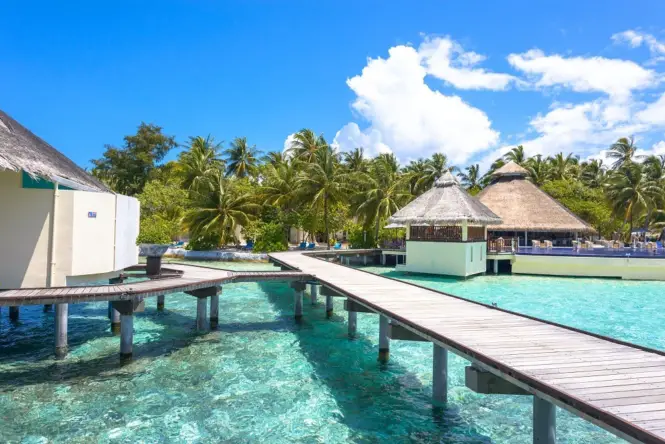
Local Islands for Budget Travelers
Here are some of the local islands you can stay at in Maldives.
Maafushi Island
Maafushi is currently the most popular local island for budget travelers in Maldives. It’s a main tourist hub, with over 30+ accommodations, as well as restaurants and tour agencies.
I recommend staying in Maafushi Island if you’re in a budget. It’s easy and convenient. For a solo traveler like me, it’s easy to find joiner tours and book inter-island transfers. For me, the bikini beaches are only passable but you can book tours to nearby sand banks and islands which will make your stay worth it.
How to get here:
- Option 1: From the airport, there are speedboats that directly go to Maafushi (travel time 30 minutes). iCom Tours, Shadow Palm and Maafushi Tours are speedboat companies that ply this route. A one-way speedboat ride costs $20 (P1000).
- Option 2: This option is cheaper but also takes longer (travel time 1.5-2 hours). From the airport, there are direct ferries to Maafushi. If for some reason you missed the direct ferries, you can also go on a ferry to Male ($1 / P50) and then take a taxi (flat rate of $2 / P100) to the jetty for the public ferry to Maafushi ($2 / P100). The ferry schedule is at 3PM everyday, except Fridays.
Personally, I prefer going on a speedboat as the price difference offsets the time you’d be waiting.
Suggested resorts:
- Maafushi Inn. Offers affordable sea-view rooms. Book here via Agoda or Booking.
- Reyva Inn. Book here via Agoda.
- Kurumba Villa. Book here via Agoda.
- Medhufaru Inn. Book here via Agoda.
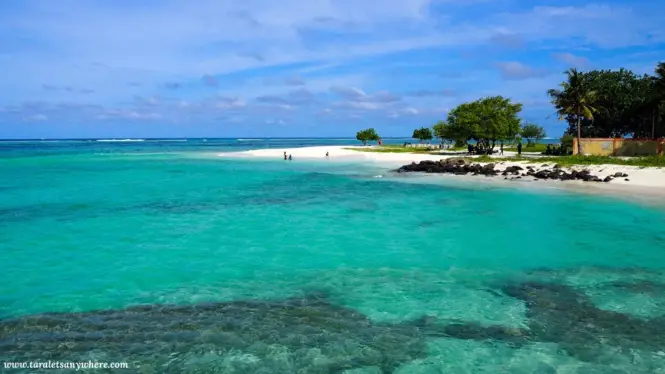
Gulhi Island
Gulhi is a local island similar to Maafushi, but quieter and less crowded. Its bikini beach is a long stretch of white-sand, with one end of the shore a playing ground for baby sharks. It has a house reef where you can snorkel and the end of the beach is home to baby sharks.
A lot of foreign backpackers prefer Gulhi over Maafushi. It all comes down to taste. Here you can swim and relax, but there are also fewer shops and restaurants. If you’re traveling solo, make sure to inquire beforehand if there are other travelers you can go with on boat tours, otherwise it will be very expensive for you.
How to get here:
- From the airport, ride a public ferry or speedboat to Gulhi Island. Sea transfers going to Maafushi usually stop by Gulhi Island first.
Suggested resorts:
- Silver Shade Guesthouse. A nice, clean guesthouse. The owner Samad is very welcoming and friendly. During my stay, he took me snorkeling on the beach and even invited me to join him for dinner. The guesthouse offers boat tours and diving. Book here via Agoda or Booking.
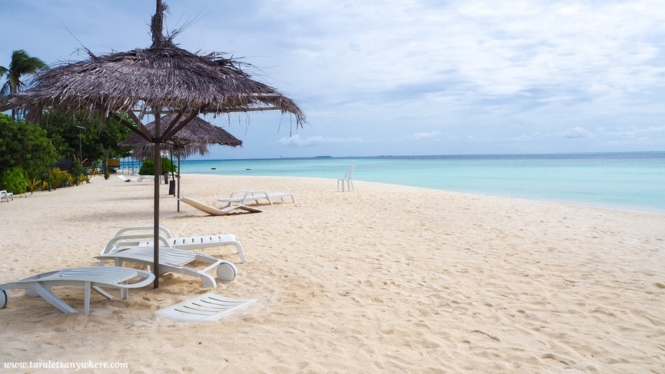
Fulidhoo Island
In my opinion, Fulidhoo Island is the best local island in Maldives. It represents the Maldives I see in post cards — beautiful beach, never-ending light-blue water on white sand, with coconut and other trees for shade. I only stayed here for a night and wished I booked longer.
Fulidhoo Island can also be visited during a snorkeling tour from Maafushi Island.
How to get here:
- From Villingili Terminal in Male or Maafushi jetty, ride a ferry to Fulidhoo Island.The ferry runs thrice a week (travel time 3 hours). Here is the timetable to Fulidhoo via Atoll Ferry.
- There is also a speedboat from Male to Fulidhoo ($45 / P2300).
Suggested resorts:
- Galaxy Sunrise. This guesthouse is the best room I’ve had in Maldives and it’s affordable too. It has its own private beach where you can relax, and it’s near the bikini beach also. It’s located in the part of the island where you can see the sunrise (which, by the way, was very beautiful). The owner Bushree is also very welcoming. Book here via Booking.
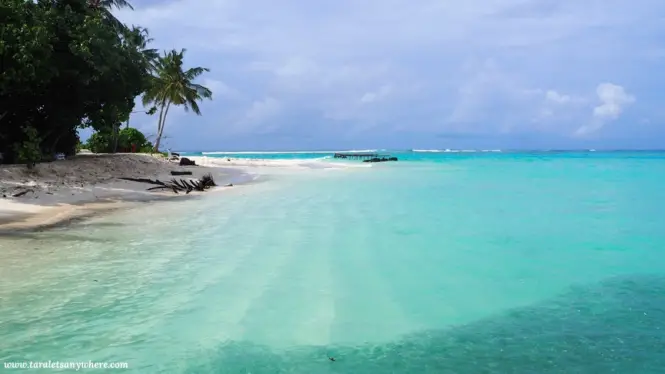
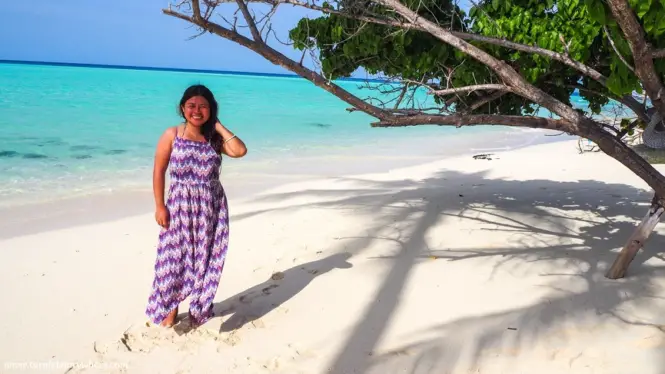
Others
There are lesser-known local islands that offers great activities at cheap prices as well, such as Thulusdhoo Island.
If you have money to splurge, consider staying in the most expensive resorts in Maldives for a truly memorable tropical experience.
What to do in Maldives
Here’s a summary of the activities you can do in Maldives. If you’re looking for other options, read our separate guide on Best Things to Do in Maldives.
1. Beach bum.
Obviously, you’re here to enjoy the dazzling blue waters of this island nation.
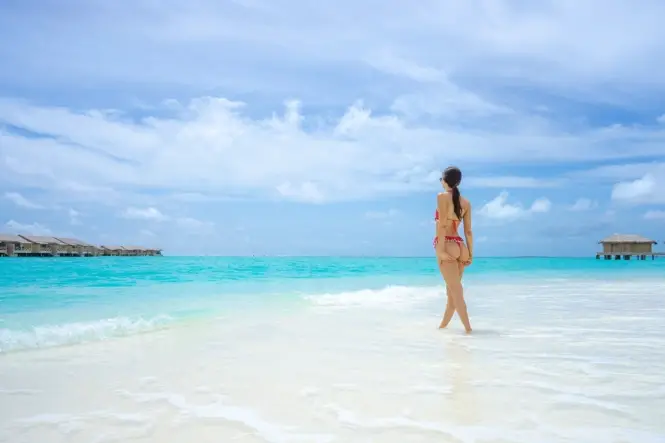
2. Book a snorkeling or sand bank tour
A snorkeling tour includes various stops where you can see corals, fishes, sometimes even dolphins and sharks. Depending on the package, a visit to a sand bar may also be included. You can also book a separate tour for having a picnic at a sand bank.
A tour costs at $25-35 (P1200-1700). Excursions and tours can be arranged by your accommodation.
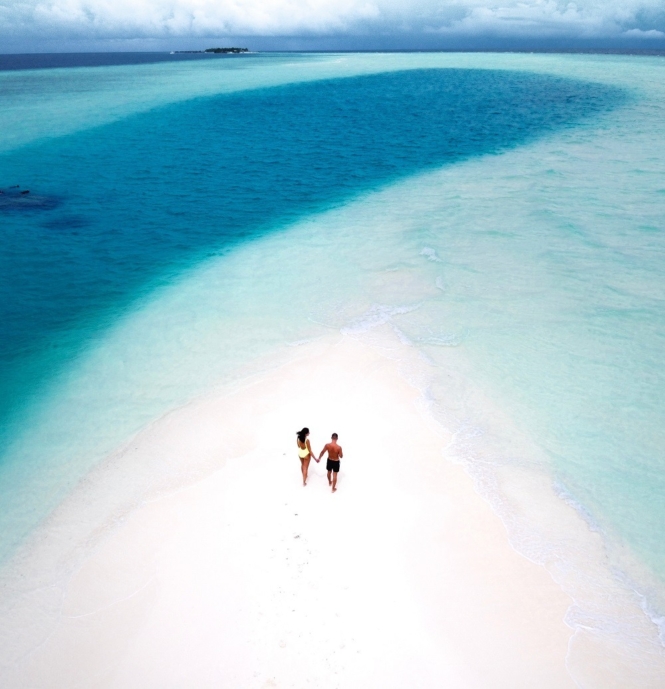
3. Sunset fishing and barbecue
This is another type of tour where you go fishing and then grill what you caught for dinner. Rate is about $25 (P1250) per person.
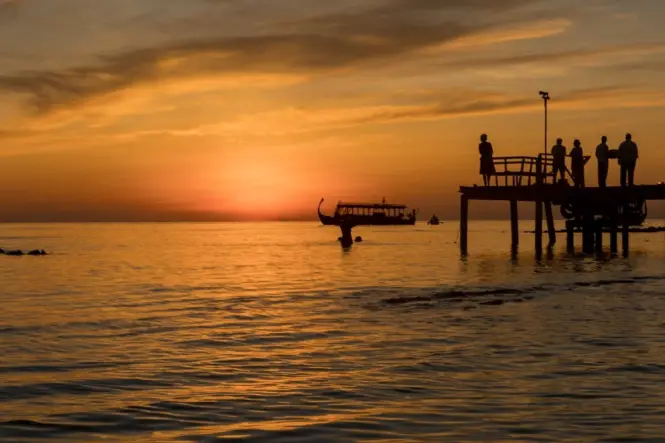
4. Diving
Maldives is a great dive destination and considered one of the best in the world. The diving season runs all-year round. As a general rule, it’s best to dive on the western side of any atoll from May to November and on the eastern side from December to April for better visibility and reef life.
Aside from corals, you can also see various types of fishes, sea turtles, manta rays, dolphins and different types of sharks. Both introductory and professional dive packages are available. Introductory dive costs about $70 (P3700).
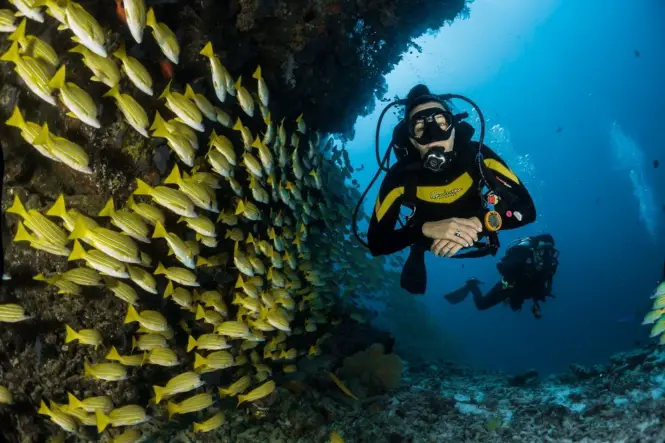
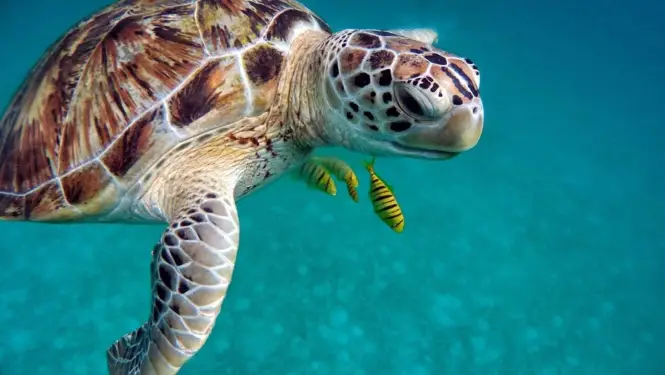
5. Get a day pass in a private resort.
From Maafushi, there are various private resorts which you can visit for a day, including Adaaran Club Rannalhi, Adaaran Prestige Vaadoo, Centara Rasfushi, Fihalhohi and Rihiveli resorts.
As mentioned above, this can also be arranged by your accommodation.
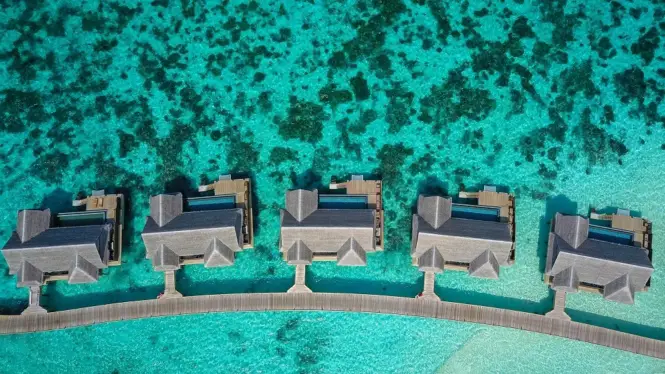
For the resort day tour, I went to Fihalhohi Resort. It costs $80 or $110 (including lunch buffet), including speedboat transfer from/to Maafushi and entrance fees. To be honest, it was a little underwhelming at first. I was finally able to see the water villas but it didn’t look as majestic as it does in pictures. There’s a beautiful beach that reminded me of Calaguas, but not necessarily better. However, the resort has great marine life. Around it you can snorkel and see colorful fishes and manta rays. There’s even an area where you can spot dolphins.
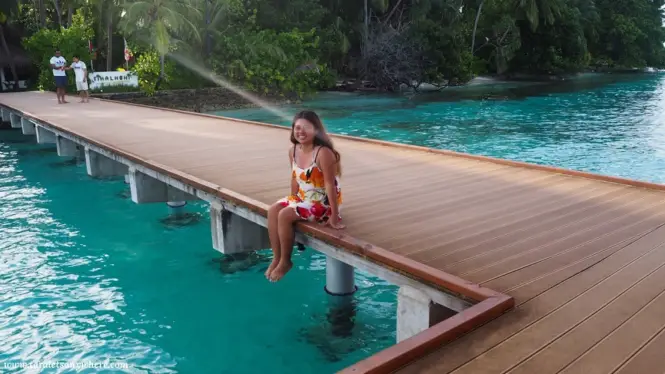
Where to eat
There are tons of Sri Lankan-influenced and Indian restaurants in Maldives. Generally, you can get a decent meal for $4-10 (P200-500). You might also want to ask your guesthouse to serve you a Maldivian breakfast in the mornings.
Here are some restaurants you can check out in Maafushi:
- Arena Beach Resort. This sea-side restaurant serves dinner buffet for only $12 (P650), excluding taxes and drinks. The spread includes barbecued seafood and pasta. The choices are limited, but quality-wise the food is delicious. It’s also very romantic since you can have a table in the beachside.
- Maafushi Floating Bar. To get here, you need to get on a small boat which will take you to this yacht where the floating bar is. For me it’s a novel experience although the alcohol options are limited when I visited.
6 Days Itinerary in Maldives
Here is a sample 6 days itinerary in Maldives.
| Day 1 | – Arrival at Male airport – Travel via speedboat to Maafushi Island – Check in at Maafushi Island – Swim at the bikini beach / other island activities |
| Day 2 | – Snorkeling or sand bank tour – Optional: Sunset fishing |
| Day 3 | – Snorkeling or sand bank tour |
| Day 4 | – Day trip to a private resort |
| Day 5 | – Check out – Transfer via public ferry to Fulidhoo Island – Check in at Fulidhoo Island – Explore Fulidhoo Island |
| Day 6 | – Take public ferry to Male airport |
In my opinion, 6 days is good enough if you manage to schedule everything properly. If you’re into other activities such as diving, you might want to stay longer.
Here are some things to note when planning your itinerary in Maldives:
- Inter-island transfers can take a lot of your time. In most cases, you might not be able to make it to a tour since tours start in the morning at around 9AM.
- If you’re on a short vacation (e.g., 5-6 days), it’s best to stay in 1-2 islands only.
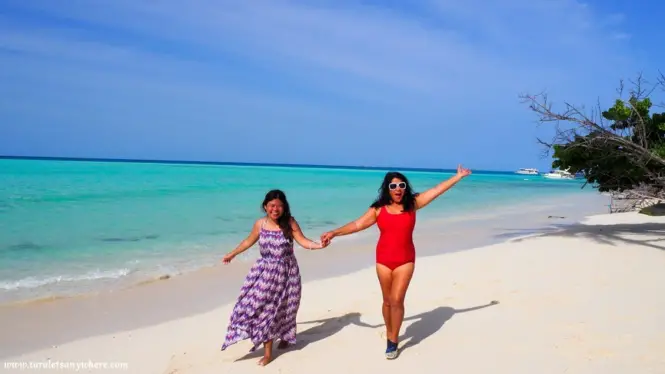
Cost estimates for a budget trip
To give you an idea, here’s a general quotation of prices in Maldives (Updated as of 2020):
- Accommodation: Single or double room $35-40 (P1500-2000)
- Snorkeling or sand bar tour: Around $25-35 (P1200-1700)
- Resort day trip: Around $100 (P5000)
- Diving: Introductory course $70 (P3700)
- Food: Regular meal $4-10 (P200-500) / Buffet $10-12 (P500-600) plus tax
- Water transport: Ferry $1.5-3.5 (P80-180) / speedboat $20-45 (P1000-2400)
For the 6-days itinerary above, a safe budget for 2 people is $450-490 (P23,000-25,000) per person excluding flights.
My budget for a 6-day solo backpacking trip to Maldives was about $430 (P22,000), excluding round-trip flights from Kuala Lumpur ($160 / P8000). It’s a bit lower than the budget estimate above because my itinerary was different (Gulhi Island – Maafushi Island – Fulidhoo Island) and I had posted a more practical itinerary where you can do more activities.
Budget travel tips to Maldives
So here’s the most important part of this guide. Budget tips for your travel to Maldives!
- Travel with a group. Traveling with other people is always cheaper. This is true for Maldives as well, where you can split costs in booking a group room.
- Book your flight tickets and reservations in advance. If you’re coming somewhere without a direct flight to Maldives (such as the Philippines), book your flight tickets months or a year ahead.
- Schedule your trip during low season. The low season is from May to November, when you can enjoy low rates. This coincides with the monsoon season (May to October), it isn’t as troublesome since you may only get occasional rainshowers.
- Stay in a local island. Local islands are not only cheap, they are also easy and convenient since you have access to establishments such as resorts or guesthouses, restaurants and tour agencies.
- Book through Airbnb. A lot of guesthouses can be found in Airbnb, and these are usually cheaper than resorts.
- If you want to splurge, go on a day tour to a private resort. This is cheaper than booking an overnight accommodation there. A day pass usually includes lunch buffet and snacks including alcoholic drinks and snorkeling rental. Rate is around $100 (P5000).
- Bring a reusable water. You can avoid the extra expense of buying a bottled water every time by bringing your own container and refilling it in your accommodation.
Things to bring
Here are things you should bring on your trip to Maldives.
- Summer dresses and cover-ups. Use when strolling along the public roads before hitting the beach.
- Sunscreen. Maldives is a tropical country and it’s close to the equator so even on cloudy days, you might get a sunburn. It’s best to wear a sunscreen everytime you go out.
- Reusable travel bottle. Keep hydrated under the sun.
- Underwater camera. Half the charm of Maldives can be seen underwater. Even if you’re only on a snorkeling tour, bring an underwater camera so you can take photos of various corals and sea creatures.
That sums up our budget travel guide to Maldives. Do you have anything to add? Let us know in the comment section below!
What to read next:
You might also want to read about:
If you like this post, pin it for later!

Katherine Cortes is a long-time backpacker and a freelance writer/editor. She likes beaches, snorkeling trips, and relaxing staycations (preferably with bath tubs!).



4 Comments
Sha
How much all your expenses in total?
Christy
Great guide. Thank you!
Regine Rose
Hello can I ask does it need a show money in order to get in Maldives and how much ? Thank you
Gela
Hi, may I ask if it was not your first overseas travel? Since you said that the immigration process from the airport is so smooth. May I know what proof of financial did you provide to them. If credit card statement will do or do I need to bring cash and exchange it to usd?